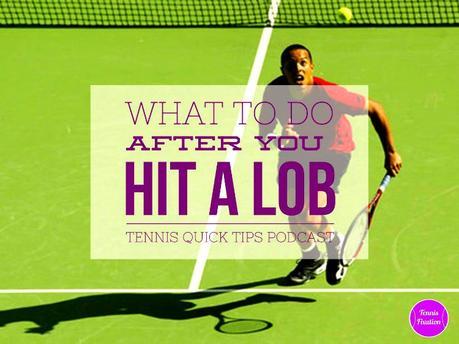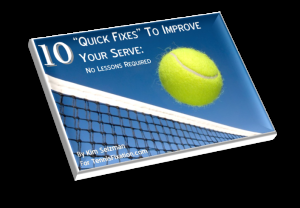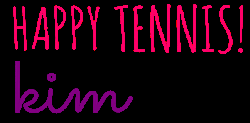Podcast: Play in new window | Download
What do you do right after you hit a lob? Do you watch your lob to see if it lands in or out? Do you watch your lob to see if it's short or deep? In this episode of Tennis Quick Tips, we're talking about the lob. I'll tell you why watching your lob is the exact wrong thing to do. And I'll tell you what to watch instead, so that you know how good your lob is and what your next shot should be. You can listen to this episode by clicking on the media player above or by listening in with your favorite podcast app. You can also subscribe in iTunes by clicking on this link: tennisfixation.com/itunes.

SHOW NOTES
Today, we're going to talk about the lob. Specifically, we're going to talk about what you should do right after you hit a lob. There's one very important thing you need to do and I notice that a lot of players, and you know that I'm talking about recreational players, they do not do this one thing. I had a partner just last week who hit a beautiful lob and didn't do the one thing she needed to do to capitalize on that. So let's talk about what it is.
Why You Should NOT Look at Your Lob
But before we talk about the one thing you need to do right after you hit a lob, let's talk about the one thing you really don't need to do when you hit a lob. And that is - you do not need to watch your lob. You certainly do not need to watch it go up in the air. And you don't need to watch it land. And you certainly do not need to watch it land to decide if it is in or out. Because, as I'm sure you know, it is not your call whether your lob lands in or out. That is up to your opponents to make that call and unless you are playing people who you know are cheating and cheating egregiously, you can't do too much about those really close calls that you're not 100% sure that your ball was actually out when it's called out or you're not 100% sure but you thought it was in when it was called out. You have got to let that go because that is your opponent's call.
So the one thing you really shouldn't be doing when you hit a lob is watching your lob. Watching how high it goes. Watching whether it lands in or out.
Why You Should Look at Your Opponent
Instead, here's the one thing you need to do right after you hit your lob. You need to watch your opponent. Your opponent's reaction will tell you everything you need to know about your lob. And if you're playing doubles, you want to focus on the opponent who is closest to the net, but, it's a lob, so you do have some time to look at both of those opponents.
If Your Opponent Gets Ready to Hit an Overhead, You've Hit a Bad Lob
Now, what do I mean by your opponent's reaction will tell you everything you need to know? When you send a lob up, if you see your opponents either staying in the net zone, if they're already there, because they may already be there because that's why you sent the lob up, then you know your lob did not go deep. And if they are raring back and getting ready to slam an overhead at you then you know your lob probably didn't go very high either. You have just hit a short, easy lob and it is probably going to come back at you as an overhead. And if you watch your opponents, you'll see them set up for that shot and you'll know exactly what kind of lob you hit. Basically, not a very good one.
If Your Opponent Turns to Run, You've Hit a Good Lob
If, on the other had, you hit your lob and your opponents again are up at the net and that's why you hit a lob, and one or both of your opponents turn to run that lob down and now you see their back, that let's you know that you've hit a good, deep lob and you should be ready to take advantage of that. When your opponent turns their back to you and has to run that lob down, that means the lob is probably going to land deep and may even land deep enough that your opponent is driven off the court and they are not going to be able to hit a very offensive shot back at you.
So, next time you hit a lob, I want you to focus on your opponents. You will see everything you need to see about your lob in the reactions of your opponents. If they look like they're excited and ready to slam an overhead back at you, back up because you know now that you didn't hit a very good lob. If on the other hand, you send your lob up and one or both opponents turns around to run it down, move in because that means you've hit a really nice, deep lob and that might be a deep enough lob to send your opponent off the court in which case you need to be ready to come in and hit a great offensive shot.
Take Advantage of Those Good Lobs and Move In to the Net
And this is where I want to go back to my comment about my partner failing to take advantage of the situation where she hit a great lob. This was during drills and she did hit a beautiful lob. It went up high, it went deep, bounced really close to the baseline. And our opponents did both turn with their backs to the net to run that lob down. I was up at the net so I took a few steps because I was like, "Whatever comes over here next I'm going to take advantage of it. I'm all over it." But my partner stayed back. She didn't really appreciate that she'd hit a great lob and she needed to come up to the net to finish that point off. So that's what I mean when I say she failed to capitalize on that really great lob. Staying back when you do something like that, it is not going to help you finish off the point. And next thing you know, it can result in you getting into a lob battle. But that is a topic for another podcast episode.
But What About the Tweener?
I will throw in this one little caveat - we see the pros do this sometimes. Someone hits a nice deep shot and the tennis pro will run it down, back to the net, and somehow hit an incredible tweener shot that turns into a winner. If you're playing people who can do that, I might not have enough tips to help you win that match. But, those are fun to watch on T.V., but I'm guessing that you won't face too many of those. If your opponent turns their back to you, get excited and get ready to hit your own winner.
That's it for this week's Tennis Quick Tip. It's a simple tip but I think if you apply this, you'll be very happy with what happens when you lob on court.
Let me know your questions or suggestions about what you'd like to hear on Tennis Quick Tips by leaving your comment in the comment box below. I'd love to hear from you.
SHARE, SUBSCRIBE AND REVIEW
Thanks so much for being a listener and friend of the Tennis Quick Tips podcast. And I hope you'll consider sharing this podcast with your friends and leaving a review of the show as it really helps it to be found by other like-minded tennis players. You can listen in, subscribe or leave a review by going to:
GET A BETTER SERVE FAST!
And if you're interested in getting a better serve - fast! - get my free ebook, 10 Quick Fixes to Improve Your Serve: No Lessons Required.

By applying the 10 simple tips to your serve that I give in this ebook, your serve can become a tool that you can use to gain control of points. It can become more powerful, more accurate, and something you're actually proud of. Just enter your email below and you'll get instant access to this free ebook as well as weekly updates with all of my best tennis tips!

© Kim Selzman 2016 All Rights Reserved
Full disclosure - Some of the links in this post are Amazon affiliate links. I make a very small commission if you purchase any item using my Amazon affiliate links. Your cost is the same for these items whether or not you use these links. This does not influence my opinion of these items and I always tell the absolute truth about every item that I review. I usually do not review items that I don't like.

